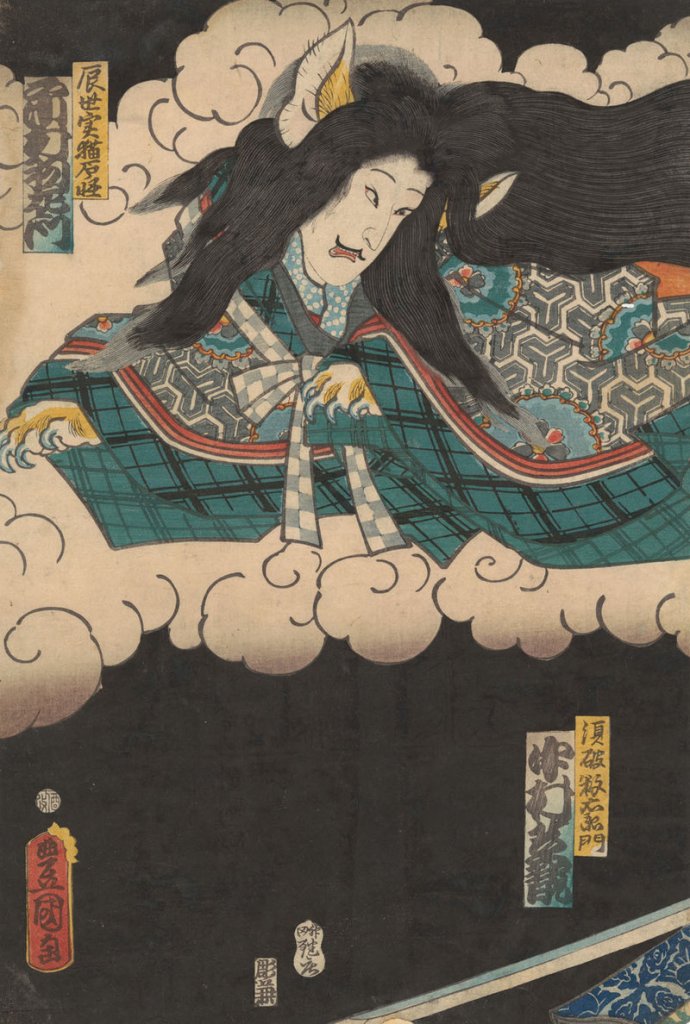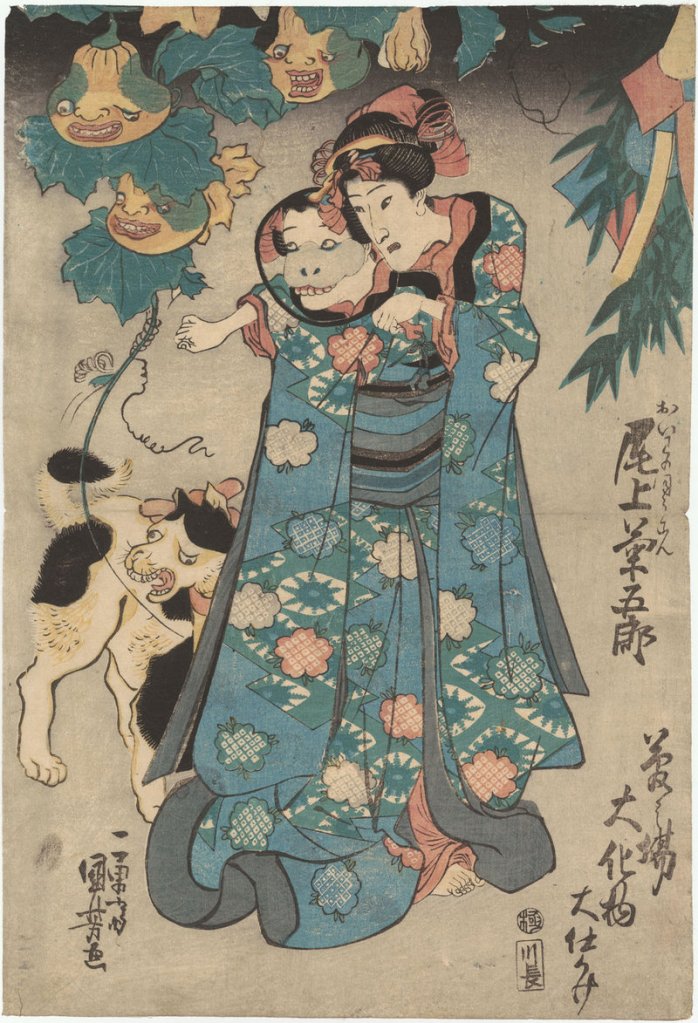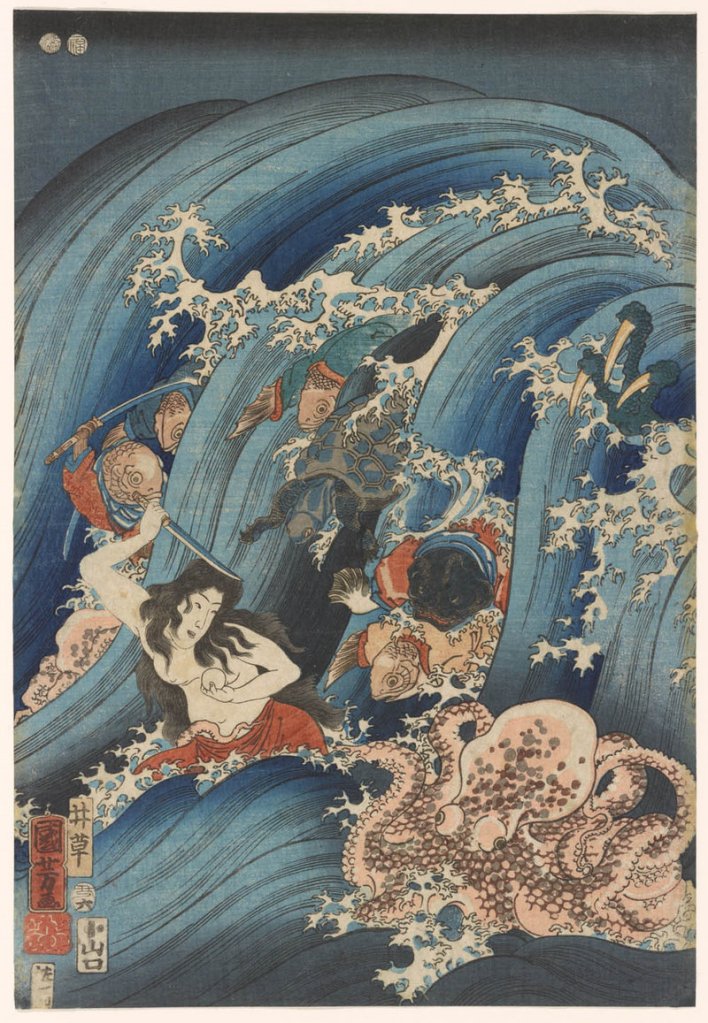Bowdoin College’s “Fantastic Stories: The Supernatural in Nineteenth-Century Japanese Prints” is fantastic in every sense of the word.
The Brunswick show features several dozen Japanese woodblock prints (Ukiyo-e) from the collection of Cornell professor Dan McKee that relate to the Japanese vision of the supernatural world: Spirits, ghosts, demons, magically endowed animals, witches, hell and more.
“Fantastic Stories” shows us something that looks very little like the Western spiritual world policed for centuries by the church. It flows unfettered from the most humorously humble to excruciating horror haunting a guilty culprit.
There are parallels to common fables. We see a fox transformed into a priest but trapped by a lure that irresistibly transforms him back. There are myths, such as the heroic story of Tamahime’s stealing a jewel to wrest control of the tides from a dark dragon.
The extraordinary latter image depicts the diver as she realizes she cannot escape the dragon (shown as claws reaching from a tsunami) and his minions (shown as charming but well-armed sea life), so she stabs herself and buries the giant pearl in her breast. Her body is later found washed ashore with the jewel intact — self-sacrificed but successful.
Most salient are stories closer to Macbeth, in which guilt devours main players. The largest of these includes five images relating to a popular 1825 ghost play reprised in the 1959 film “Yotsuya Ghost Story” by Nubuo Nakagawa.
A condensed 15-minute version of the film (not for children) runs continually, and is worth the trip by itself. It’s the powerful and terrifying story of a man, Lemon, who poisons his wife and commits several murders during his social climbing endeavors. His guilt brings on horrific ghost visions of his decomposing wife that ultimately drive him mad.
One extraordinary print depicts Lemon (very well-dressed — having married up) encountering his murdered wife and servant nailed to a door for disposal in the water. The incredible object actually folds down to reveal the other body.
Her face horribly disfigured by poison, Lemon’s wife is depicted in another print dreaming that she is not disfigured but rather that the world around her is: A dog and fruit in a nearby tree sport grotesque faces.
Prints depicting actors in popular Kabuki theater roles were very common, and play a huge role in “Fantastic Stories.” In fact, their baseball-card logic has a flavor not so different from contemporary America’s cinema celebrity worship — and more like Winslow Homer’s engraved prints in the Saturday Evening Post than fine prints sold in hifalutin’ contemporary galleries.
One of my favorite print artists is Tsukioka Yoshitoshi (1839-92). While “Fantastic Stories” is filled with big names and great works, he still stands out. Yoshitoshi’s “Tale of Genji” and “Kiyomori’s Fever Dream” rival Hieronymous Bosch’s hellish visions, and surpass virtually all Western art in terms of formal, iconographical and narrative sophistication.
Our cultural divide from Japan is most poignantly illustrated by an 1889 print depicting a story from the Tokyo Daily News in which a man was haunted by the ghost of his brother-in-law for not serving in the Japanese army. It’s a serious bit of pro-government media, and such a thing would be inconceivable in America.
While Bowdoin’s other major show is another print exhibition, and Portland’s most significant show of the moment is the public library’s print show curated by Bruce Brown, I think it’s a mistake to bury “Fascinating Stories” as a print show. The effect of Ukiyo-e has been less on prints than other Western cultural forms such as painting and cartoons.
It would be hard to overestimate the effect of Japanese prints on Western painting and pictorial culture. The most obvious connections through Van Gogh and Monet come to mind easily enough. But it’s far less obvious to connect the dots through Monet’s water lilies to Abstract Expressionism — yet Ukiyo-e helped Monet lay the groundwork for abstraction.
Another critical connection between Western art and Japanese prints comes through cartoons and animation — from black-line cartoons for children to the surprisingly long and deep history of Japanese/American animation collaboration.
My young sons’ favorite filmmaker is Hayao Miyazaki (born 1941), whose animated films such as “Ponyo” (2008), “Kiki’s Delivery Service” (1989) and “Howl’s Moving Castle” (2004) are on my short list as well. We particularly like “My Neighbor Totero” (1988) — the story of a professor’s two young daughters’ friendship with a silent but kind wood spirit while their mom recovers from cancer in a nearby hospital.
What is striking is the relationship of these rather typical postwar Japanese characters to their supernatural world. Totero may look like a giant stuffed magical hamster with googly eyes, but he is their neighbor, friend and — in time of need — their hero.
These films and prints reveal that the Japanese relationship to the supernatural is very different from ours. While my dust bunnies are simply proof that I don’t vacuum enough, Miyazaki introduces us to sweet little soot sprites who can open the door to a world that has never been ours before.
This show is amazing particularly because it reveals extraordinary psychological depth in its sophisticated presentation of Japanese morality and popular culture. But it is no less excellent as an exhibition of visual art. With so many strong print shows around Maine, “Fascinating Stories” is not to be missed.
Freelance writer Daniel Kany is an art historian who lives in Cumberland. He can be contacted at:
dankany@gmail.com
Send questions/comments to the editors.






Success. Please wait for the page to reload. If the page does not reload within 5 seconds, please refresh the page.
Enter your email and password to access comments.
Hi, to comment on stories you must . This profile is in addition to your subscription and website login.
Already have a commenting profile? .
Invalid username/password.
Please check your email to confirm and complete your registration.
Only subscribers are eligible to post comments. Please subscribe or login first for digital access. Here’s why.
Use the form below to reset your password. When you've submitted your account email, we will send an email with a reset code.